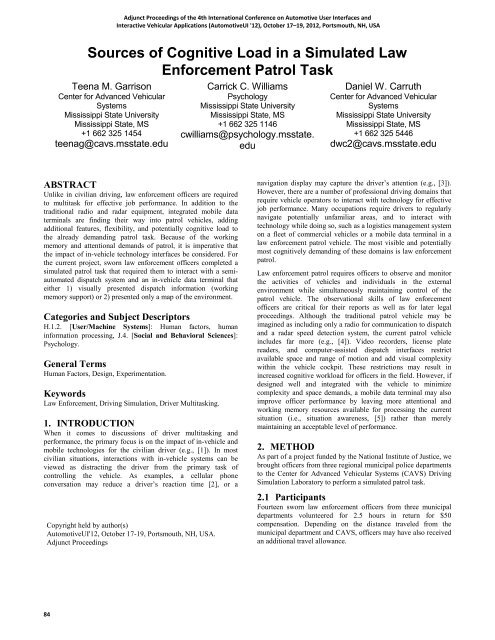12: Adjunct Proceedings - Automotive User Interfaces and ...
12: Adjunct Proceedings - Automotive User Interfaces and ...
12: Adjunct Proceedings - Automotive User Interfaces and ...
You also want an ePaper? Increase the reach of your titles
YUMPU automatically turns print PDFs into web optimized ePapers that Google loves.
Sources of Cognitive Load in a Simulated Law<br />
Enforcement Patrol Task<br />
Teena M. Garrison<br />
Center for Advanced Vehicular<br />
Systems<br />
Mississippi State University<br />
Mississippi State, MS<br />
+1 662 325 1454<br />
teenag@cavs.msstate.edu<br />
ABSTRACT<br />
Unlike in civilian driving, law enforcement officers are required<br />
to multitask for effective job performance. In addition to the<br />
traditional radio <strong>and</strong> radar equipment, integrated mobile data<br />
terminals are finding their way into patrol vehicles, adding<br />
additional features, flexibility, <strong>and</strong> potentially cognitive load to<br />
the already dem<strong>and</strong>ing patrol task. Because of the working<br />
memory <strong>and</strong> attentional dem<strong>and</strong>s of patrol, it is imperative that<br />
the impact of in-vehicle technology interfaces be considered. For<br />
the current project, sworn law enforcement officers completed a<br />
simulated patrol task that required them to interact with a semiautomated<br />
dispatch system <strong>and</strong> an in-vehicle data terminal that<br />
either 1) visually presented dispatch information (working<br />
memory support) or 2) presented only a map of the environment.<br />
Categories <strong>and</strong> Subject Descriptors<br />
H.1.2. [<strong>User</strong>/Machine Systems]: Human factors, human<br />
information processing, J.4. [Social <strong>and</strong> Behavioral Sciences]:<br />
Psychology.<br />
General Terms<br />
Human Factors, Design, Experimentation.<br />
Keywords<br />
Law Enforcement, Driving Simulation, Driver Multitasking.<br />
1. INTRODUCTION<br />
When it comes to discussions of driver multitasking <strong>and</strong><br />
performance, the primary focus is on the impact of in-vehicle <strong>and</strong><br />
mobile technologies for the civilian driver (e.g., [1]). In most<br />
civilian situations, interactions with in-vehicle systems can be<br />
viewed as distracting the driver from the primary task of<br />
controlling the vehicle. As examples, a cellular phone<br />
conversation may reduce a driver’s reaction time [2], or a<br />
Copyright held by author(s)<br />
<strong>Automotive</strong>UI'<strong>12</strong>, October 17-19, Portsmouth, NH, USA.<br />
<strong>Adjunct</strong> <strong>Proceedings</strong><br />
84<br />
<strong>Adjunct</strong> <strong>Proceedings</strong> of the 4th International Conference on <strong>Automotive</strong> <strong>User</strong> <strong>Interfaces</strong> <strong>and</strong><br />
Interactive Vehicular Applications (<strong>Automotive</strong>UI '<strong>12</strong>), October 17–19, 20<strong>12</strong>, Portsmouth, NH, USA<br />
Carrick C. Williams<br />
Psychology<br />
Mississippi State University<br />
Mississippi State, MS<br />
+1 662 325 1146<br />
cwilliams@psychology.msstate.<br />
edu<br />
Daniel W. Carruth<br />
Center for Advanced Vehicular<br />
Systems<br />
Mississippi State University<br />
Mississippi State, MS<br />
+1 662 325 5446<br />
dwc2@cavs.msstate.edu<br />
navigation display may capture the driver’s attention (e.g., [3]).<br />
However, there are a number of professional driving domains that<br />
require vehicle operators to interact with technology for effective<br />
job performance. Many occupations require drivers to regularly<br />
navigate potentially unfamiliar areas, <strong>and</strong> to interact with<br />
technology while doing so, such as a logistics management system<br />
on a fleet of commercial vehicles or a mobile data terminal in a<br />
law enforcement patrol vehicle. The most visible <strong>and</strong> potentially<br />
most cognitively dem<strong>and</strong>ing of these domains is law enforcement<br />
patrol.<br />
Law enforcement patrol requires officers to observe <strong>and</strong> monitor<br />
the activities of vehicles <strong>and</strong> individuals in the external<br />
environment while simultaneously maintaining control of the<br />
patrol vehicle. The observational skills of law enforcement<br />
officers are critical for their reports as well as for later legal<br />
proceedings. Although the traditional patrol vehicle may be<br />
imagined as including only a radio for communication to dispatch<br />
<strong>and</strong> a radar speed detection system, the current patrol vehicle<br />
includes far more (e.g., [4]). Video recorders, license plate<br />
readers, <strong>and</strong> computer-assisted dispatch interfaces restrict<br />
available space <strong>and</strong> range of motion <strong>and</strong> add visual complexity<br />
within the vehicle cockpit. These restrictions may result in<br />
increased cognitive workload for officers in the field. However, if<br />
designed well <strong>and</strong> integrated with the vehicle to minimize<br />
complexity <strong>and</strong> space dem<strong>and</strong>s, a mobile data terminal may also<br />
improve officer performance by leaving more attentional <strong>and</strong><br />
working memory resources available for processing the current<br />
situation (i.e., situation awareness, [5]) rather than merely<br />
maintaining an acceptable level of performance.<br />
2. METHOD<br />
As part of a project funded by the National Institute of Justice, we<br />
brought officers from three regional municipal police departments<br />
to the Center for Advanced Vehicular Systems (CAVS) Driving<br />
Simulation Laboratory to perform a simulated patrol task.<br />
2.1 Participants<br />
Fourteen sworn law enforcement officers from three municipal<br />
departments volunteered for 2.5 hours in return for $50<br />
compensation. Depending on the distance traveled from the<br />
municipal department <strong>and</strong> CAVS, officers may have also received<br />
an additional travel allowance.





